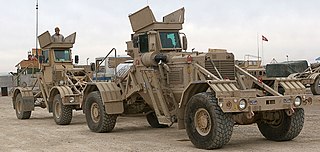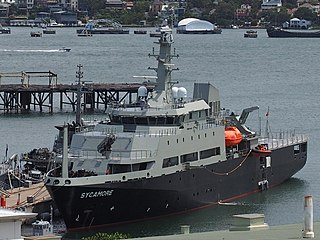
An unmanned aerial vehicle (UAV), commonly known as a drone, is an aircraft without any human pilot, crew, or passengers on board. UAVs were originally developed through the twentieth century for military missions too "dull, dirty or dangerous" for humans, and by the twenty-first, they had become essential assets to most militaries. As control technologies improved and costs fell, their use expanded to many non-military applications. These include aerial photography, precision agriculture, forest fire monitoring, river monitoring, environmental monitoring, policing and surveillance, infrastructure inspections, smuggling, product deliveries, entertainment, and drone racing.

A metal detector is an instrument that detects the nearby presence of metal. Metal detectors are useful for finding metal objects on the surface, underground, and under water. The unit itself consists of a control box, and an adjustable shaft, which holds a pickup coil, which can vary in shape and size. If the pickup coil comes near a piece of metal, the control box will register its presence by a changing tone, a flashing light, and or by a needle moving on an indicator. Usually the device gives some indication of distance; the closer the metal is, the higher the tone in the earphone or the higher the needle goes. Another common type are stationary "walk through" metal detectors used at access points in prisons, courthouses, airports and psychiatric hospitals to detect concealed metal weapons on a person's body.

The Mine detector (Polish) Mark I was a metal detector for landmines developed during World War II. Initial work on the design had started in Poland but after the invasion of Poland by the Germans in 1939, and then the Fall of France in mid-1940, it was not until the winter of 1941–1942 that work was completed by Polish lieutenant Józef Kosacki.

Demining or mine clearance is the process of removing land mines from an area. In military operations, the object is to rapidly clear a path through a minefield, and this is often done with devices such as mine plows and blast waves. By contrast, the goal of humanitarian demining is to remove all of the landmines to a given depth and make the land safe for human use. Specially trained dogs are also used to narrow down the search and verify that an area is cleared. Mechanical devices such as flails and excavators are sometimes used to clear mines.

The Scientific and Technological Research Institution of Turkey is a national agency of Turkey whose stated goal is to develop "science, technology and innovation" (STI) policies, support and conduct research and development, and to "play a leading role in the creation of a science and technology culture" in the country.
IMB, the Irvine-Michigan-Brookhaven detector, was a nucleon decay experiment and neutrino observatory located in a Morton Salt company's Fairport mine on the shore of Lake Erie in the United States 600 meters underground. It was a joint venture of the University of California, Irvine, the University of Michigan, and the Brookhaven National Laboratory. Like several other particle detectors, it was built primarily with the goal of observing proton decay, but it achieved greater fame through neutrino observation, particularly those from Supernova SN 1987A.
The Kamioka Observatory, Institute for Cosmic Ray Research is a neutrino and gravitational waves laboratory located underground in the Mozumi mine of the Kamioka Mining and Smelting Co. near the Kamioka section of the city of Hida in Gifu Prefecture, Japan. A set of groundbreaking neutrino experiments have taken place at the observatory over the past two decades. All of the experiments have been very large and have contributed substantially to the advancement of particle physics, in particular to the study of neutrino astronomy and neutrino oscillation.

The Schiebel Camcopter S-100 is an Austrian unmanned aerial vehicle (UAV) using a rotorcraft design.

USS Detector (AM-429/MSO-429) was an Agile-class minesweeper built for the United States Navy.

The Husky VMMD is a configurable counter-IED MRAP vehicle, developed by South African-based DCD Protected Mobility and American C-IED company Critical Solutions International. Designed for use in route clearance and de-mining operations, the Husky is equipped with technologies to help detect explosives and minimise blast damage.

Serine/threonine-protein kinase PRKY is an enzyme that in humans is encoded by the PRKY gene.

The UMS Skeldar V-200 is a medium-range VTOL UAV developed by the Swedish aerospace company Saab. The Skeldar can be used for surveillance, intelligence gathering, light cargo transportation, and electronic warfare.
The Austro Engine EA50R is an Austrian aircraft engine, produced by Austro Engine of Wiener Neustadt for use in motorgliders and UAVs.

MV Sycamore is a training ship built to support the Royal Australian Navy (RAN) by Netherlands shipbuilders Damen Group. The vessel was built in Damen's shipyard in Haiphong, Vietnam and launched in 2016. The ship is operated for the RAN by Teekay Australia and entered service in 2017.
822X Squadron is a Royal Australian Navy Fleet Air Arm squadron established in October 2018. Its role is to trial unmanned aerial vehicles.

Global Industrial & Defence Solutions (GIDS) is a Pakistani state-owned defence conglomerate, and the country's largest defence manufacturer, offering products for military applications. GIDS has exported to 16+ countries and is currently under engagement with 30+ countries across the globe.
King Abdullah II Air Base is an airbase of the Royal Jordanian Air Force near Zarqa, Zarqa Governorate, Jordan.












